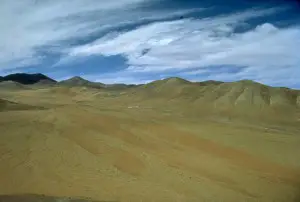
An oasis is more than a refreshing place to stop while traveling through the desert. That water and respite from the sun can be the difference between life and death for a weary traveler. Though most people have a picture in their heads about what an oasis is, there are things they might not know. An oasis is a body of water, usually surrounded by vegetation, and typically found in the lifelessness of the desert.
Fact 1: The plural of oasis is oases. Oasis is derived from the Egyptian wahah, meaning dwelling place. In the Southwestern United States, oases are known as cienega.
Fact 2: The typical oasis will have plant life around a water source, but this water could be fresh or salt water.
Fact 3: Most oases are formed around a confined aquifer, or where the ground under the water is not porous, but the ground above it is. This allows the water from rain to seep into the ground, but instead of draining away, it pools there. Eventually, the pool will be deep enough that some will leak back onto the surface of the planet, feeding plants and creating an oasis.
Fact 4: Some oases are manmade, as people drilled wells and planted vegetation. This was hard work, which eventually evolved into a planting system that made the best use of the resources available. Tall trees, like date palms, provide shade for shorter trees and crop plants. These plants are grown around the roots of the tall trees, so all are equally distant from the source of water.
Fact 5: Learning how oases work, and how to efficiently grow crops around an oasis has led to a new concept in ecology; oasification. In dry climates that are prone to soil erosion, manmade oases work as a bowl to catch the water and nutrients that are leaving the area. Stopping the runoff and accumulating them, crops can be grown in the new oasis, and their roots will enlarge the area of accumulation until the whole field is useable again.
Fact 6: Desert travelers have long used oases as places to rest, replenish water and food supplies, and as a way to chart their path through the desert. As some oases are only around for part of the year, it adds an extra dimension to navigation, when being lost can be deadly.
Fact 7: New oases may be formed after windstorms. The wind moves enough of the sand for seeds blown in by that same wind to dig roots down to the water.
Fact 8: Some rivers go underground, seeming to taper off. These are not very deep, and windstorms can uncover parts of the underground stream. If left uncovered, an oasis will form around this exposed part of the river, so not all oasis are made of ponds or still-water.
Fact 9: All of the worlds’ deserts contain oases, and they have been attractive places for people to start towns or marketplaces.
Fact 10: Antarctica has oases, but these are dry, ice-free valleys in a land of lifeless ice.










Leave a Reply